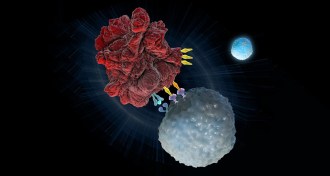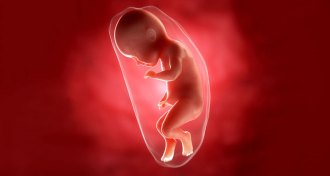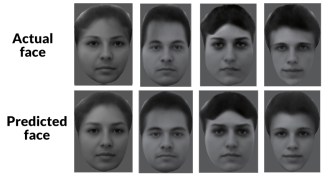News
-
 Health & Medicine
Health & MedicineTherapy flags DNA typos to rev cancer-fighting T cells
Genetic tests help identify cancer patients who will benefit from immune therapy.
-
 Paleontology
PaleontologyPrimitive whales had mediocre hearing
Fossils suggest that early whale hearing was run-of-the-mill, along the same line as that of land mammals.
-
 Climate
ClimateClimate change might help pests resist corn’s genetic weapon
Rising temperatures may allow pests to eat corn that is genetically modified to produce an insect-killing toxin.
By Susan Milius -
 Humans
HumansFor humans, the appeal of looking at faces starts before birth
New research suggests that 8-month-old fetuses, like newborns, are particularly interested in looking at faces.
-
 Anthropology
AnthropologyOldest known Homo sapiens fossils come from northern Africa, studies claim
Moroccan fossils proposed as oldest known H. sapiens, from around 300,000 years ago.
By Bruce Bower -
 Astronomy
AstronomyEinstein’s light-bending by single far-off star detected
A measurement so precise Einstein thought it couldn't be done has demonstrated his most famous theory on a star outside the solar system for the first time.
-
 Life
LifeWhen it comes to the flu, the nose has a long memory
Mice noses have specialty immune cells with long memories.
-
 Health & Medicine
Health & MedicineWhen preventing HIV, bacteria in the vagina matter
Vaginal bacteria affect how well microbicide gels used to prevent HIV work.
-
 Neuroscience
NeuroscienceBrains encode faces piece by piece
Cells in monkey brains build up faces by coding for different characteristics.
-
 Physics
PhysicsLIGO snags another set of gravitational waves
Two black holes stirred up the third set of gravitational waves ever detected.
-
 Archaeology
ArchaeologyPeru’s plenty brought ancient human migration to a crawl
Ancient Americans reached Peru 15,000 years ago and stayed put, excavations suggest.
By Bruce Bower -
 Planetary Science
Planetary ScienceJuno spacecraft reveals a more complex Jupiter
NASA’s Juno spacecraft has sent back unexpected details about Jupiter, giving scientists their first intimate look at the giant planet.